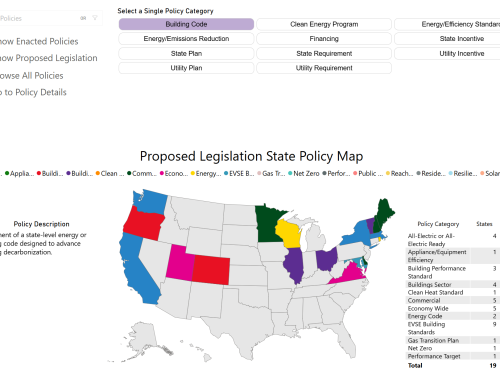
After the votes for the 2022 election were counted, Minnesota’s Democratic party, the DFL, celebrated its newfound trifecta: Control of Minnesota’s governor’s office, House, and Senate, even if their majority in the Upper House is held by just one seat.
The DFL was not going to let its first trifecta since 2014 go to waste, quickly taking assertive legislative action including the $72 billion One Minnesota Budget enacted this May. In terms of energy policies, these initiatives include requiring a carbon-free electrical grid by 2040, the HF2310 Energy Omnibus bill including $216 million for energy financing, and a $115 million fund for matching federal energy infrastructure grants. Pre-weatherization in Minnesotan homes, residential electric panel grants, and heat pump rebates are some of star features for buildings.
These policies have generated ripples spreading throughout the Midwest. The Michigan Democratic party also achieved a trifecta in the 2022 election cycle and is eager for climate action — including three potential new bills to spur affordable clean energy and more ambitious climate goals — and the region as a whole is ripe with potential for building electrification.
At this policy juncture, it is worth analyzing the path to building electrification in the Midwestern states and the region as a whole.
The Buildings Hub’s Spotlight States dashboard currently tracks policies from seven Midwestern states: Illinois, Indiana, Iowa, Michigan, Minnesota, Ohio, and Wisconsin. Additionally, Atlas Buildings Hub’s Residential Building Characteristics dashboard surfaces data from the 2020 US Residential Energy Consumption Survey, or RECS, as well as past iterations of the survey.
Table 1: Key Electrification Metrics Across the Midwestern Census Region (2015 and 2020)
| Electrification Metric | Percent of Midwestern Households, 2015 | Percent of Midwestern Households, 2020 |
| All-Electric Housing Units | 15 | 14 |
| Households with Electricity for Primary Space Heating | 21 | 19 |
| Households with Heat Pump as Primary Space Heating Equipment | 3 | 4 |
Data: Energy Information Agency Residential Energy Consumption Survey (2015 and 2020). Data encompasses states in the Energy Information Agency Midwest Census Region: Illinois, Indiana, Iowa, Kansas, Michigan, Minnesota, Missouri, Nebraska, North Dakota, Ohio, South Dakota, and Wisconsin.
Table 1 represents the percentage of Midwestern households with various electrification metrics between 2015 and 2020. Unfortunately, the Midwestern building electrification transition from 2015 to 2020 is almost nonexistent. For almost all categories, electrification fell; only electric heat pumps saw about a 1 percent increase in Midwestern residences.
Between 2015 and 2020, a smaller share of new household constructions (29 percent) relied on gas as their primary fuel when compared to between 2010 and 2015 (36 percent), potentially driving the decrease across electrification metrics.
Table 2: Michigan and Minnesota’s Building Electrification Progress (2020)
| Electrification Metric | Percent of Michigan Households | Percent of Minnesota Households |
| All-Electric Housing Units | 6 | 9 |
| Households with Electricity for Primary Space Heating | 10 | 14 |
| Households with Heat Pump as Primary Space Heating Equipment | 2 | 2 |
| Households with Electric Cooktops | 54 | 70 |
| Households with Electric Water Heaters | 27 | 37 |
Data: Energy Information Agency Residential Energy Consumption Survey (2020)
Analysis: Atlas Buildings Hub
Michigan and Minnesota in 2020 are lagging behind the pack in the region and the nation at large. The states’ fuel mixes for space heating bring this into greater clarity when compared to Midwestern and national averages.

Data: Energy Information Agency Residential Energy Consumption Survey (2020). Analysis: Atlas Buildings Hub
Nationally, 51 percent of households utilized piped gas as their primary space heating fuel in 2020, a figure Michigan surpassed by 26 percentage points and Minnesota by 17 percentage points. Further, while 34 percent of households relied on electricity, only 10 and 14 percent of Michigan and Minnesota households rely on electricity, respectively. Most jarringly, propane-reliant households stand at 4 percent nationally; Michigan has more than double and Minnesota more than triple the share of propane-reliant households.
With this national context, the transition towards building electrification for the Midwest remains a daunting task. Progress remains slow, with the vast majority of households reliant on some form of fossil fuel for key end uses (space heating, water heating, cooking). At the same time, these states exist in some of America’s coldest climates, which may explain their higher-than-average gas usage. Cold climate heat pumps and other efficient electric equipment would greatly benefit Midwesterners, resulting in higher household energy efficiencies, stronger health outcomes, especially for children, and long-term pocketbook savings.
As Michigan and Minnesota move to implement more climate-forward policies and funding programs, we may begin to see these Midwestern states pull ahead to become regional leaders in building electrification. The newly enacted Minnesota budget, chock full of beneficial electrification and home health funding, for example, will move the needle as the Gopher State strives to achieve a greener housing stock. As the Democratic party in Michigan moves to takes advantage of its newfound majority, we may soon see similar legislative action in Lansing as well.



